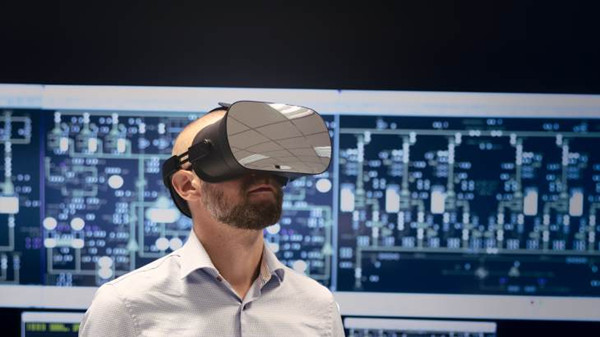Fortum develops high-definition VR simulator
Finnish utility Fortum has developed the world's first fully dynamic and interactive virtual reality (VR) control room for training operators at its Loviisa nuclear power plant. The company says the cost of a full-scale, full-scope VR simulator is a fraction of that to build a physical simulator.

Fortum eSite's Joakim Bergroth using the VR-1 headset (Image: Fortum)
Operators of plants in safety-critical facilities - such as nuclear power plants - are traditionally trained in a physical simulator - an exact, functional replica of the plant's control room.
Fortum eSite is the company's internal venture, founded earlier this year, to develop industrial-grade VR solutions to safety-critical environments and the process industry in general.
Joakim Bergroth, product lead at Fortum eSite, said: "In safety-critical environments and process industries, human error can lead to serious accidents and production losses. Millions of euros are used to build physical simulators where operators can practise different scenarios from small disturbances, such as pipe leakages, to severe accident training. The physical simulators are usually fully booked, which doesn't leave much time for additional testing and evaluations." He said the cost of a VR simulator is about one-tenth of the cost of building a physical simulator.
A hurdle to the widespread use of VR technology in simulators for facilities such as nuclear power plants has been the resolution of existing VR headsets on the market. In reactor control rooms, there are usually hundreds of hardwired panels and detailed monitors with real-time information on pipes and gauges. Visualising these using VR has previously been difficult.
"When the resolution is poor, it is an extra thing to think about for the operator and they act differently compared to real life," Bergroth said.
Fortum eSite has used the VR-1 headset developed by Finnish technology company Varjo for its VR training room. This headset, launched in February, has a resolution of over 60 pixels per degree – the equivalent of 20/20 vision. Designed for use in complex and demanding industries, it comes with the world's most advanced integrated eye tracking technology and is compatible with the most popular 3D software tools.
"With the Varjo VR-1, the visual fidelity of our virtual simulator is finally on a level that it should be," said Bergroth. "With VR-1, I was able to do things that I haven't been able to do before with any other off-the-shelf VR headset, such as read manuals and distinguish the smallest digits from the control room displays with ease. No other VR device can perform this kind of realism."
The design process is another crucial aspect in safety-critical environments. For nuclear power plant control rooms, validations are a compulsory part of the design process. All operator procedures, new display systems and hardwired panel designs need to be validated in physical simulators before they are used in the actual control room to ensure they work as intended. Before VR simulators, validations were typically done very late in the project, and any design changes needed time-consuming changes in the physical simulator on site.
"In the worst case, a critical design error in the validation could have postponed the project by a full year, because of no time to fix the error," Bergroth said. "With the help of VR, pre-validations and evaluations can be done several months ahead of time. There is plenty of time to fix errors and findings before physical implementations. That saves an enormous amount of time, money and grey hair in general."
He said the first time a pre-validation was carried out using the VR simulator, it was then found all the biggest errors had been fixed when subsequently checked in the physical simulator. "It saved us thousands of working hours, and monetary-wise probably hundreds of thousands of euros."
The realism of the VR simulator meant Fortum eSite was able to add elements to the training that have not been possible before.
"We can also add natural phenomena like fire, smoke, flood or earthquakes that are impossible to accomplish in a physical simulator or environment," Bergroth said. "With VR-1, it is possible to get the stress factors to a more realistic level, so that we can learn more about how well our human machine interfaces are working. Also the operators are more prepared if something like that would happen in real life. More realistic training adds to the overall safety and efficiency of a power plant.
"With VR-1, the end-users in nuclear operations and many other industries are more likely to see and accept the possibilities of VR and what it brings to their industry. That is game-changing."
Operators at Loviisa are preparing to take VR into training and daily use at the plant site. Already, 90% of workers at the site have been trained in VR environments.
- China Institute of Atomic Energy
- Nuclear Power Institute of China
- Southwestern Institute of Physics
- China Nuclear Power Operation Technology Corporation, Ltd.
- China Nuclear Power Engineering Co., Ltd.
- China Institute for Radiation Protection
- Beijing Research Institute of Uranium Geology (BRIUG)
- China Institute of Nuclear Industry Strategy (CINIS)
- China Nuclear Mining Science and Technology Corporation


